Smart Tree: An Architectural, Greening and ICT Multidisciplinary Approach to Smart Campus Environments
Abstract
:1. Introduction
2. Related Work
3. Context, Requirements and Proposed System
3.1. Architecture
- Generation of friendly spaces for leisure and study surrounded by greenery.
- Inventory of materials and construction elements from the UMA wastes destined for disposal.
- Reused materials: A second life cycle that, through a new architectural ecodesign, provides a new use in a new context.
- Industrialized architecture: Industrialization understood as architectural production method and sustainable construction system that can respond to needs of workspaces and housing in large cities [56]. At the same time we consider dry assembly systems as a tool that allows the incorporation of reused materials into the construction process [57], and also makes it possible to recover and recycle the materials after their life cycle, opening the way to the so desired building with ecological footprint 0.
- Transformable and Adaptable to spaces both outside and inside public buildings.
- Activating space of nodes or green islands: once the vegetation grows, the prototype shall be able to be transported and migrate to other places to green them and provide it with ICT systems.
- Scalability to each specific place and location.
- Natural vegetation support structure.
- Urban furniture support (ergonomic and ecodesign) for indoor and outdoor living and working rooms.
- Energy self-sufficiency: Support of photovoltaic collectors included a storage system back-up.
- Support of a network of environmental and subsoil sensors.
3.2. Cyclic Economy
- Select low-impact materials, prioritizing secondary raw materials.
- Minimize the consumption of auxiliary materials.
- Minimize energy consumption in production, reducing the manufacturing stages.
- Extend the useful life of the furniture, define processes and maintenance stages.
- Optimize the useful life of the product by increasing the number of life cycles.
- Design furniture by modules to facilitate disassembly/assembly.
3.3. Greening
- Use of primarily native flora adapted to the Mediterranean macrobioclimate of the environment following the main flora of our Mediterranean area [48].
- Use of plants of reduced water requirements and maintenance [66]. The use of perennial plants, according with the established concept by [67], was a priority. Reference [48] was the main source of information for this selection, while references [19,42,68] were to provide the information about the requirements of the selected plants.From an ecological and functional point of view, these kinds of plants are considered arid-active or persistent species maintaining active shoots during the unfavorable season (which is consider the summer in a Mediterranean area [69]).
- Use of plants which maintain their leaves all year (evergreen species) in order to provide shade, barrier effect and weather pollution protection to the space through all the year. These plants are to be combined with deciduous plants for areas where the priority is the exposure to sunlight in winter.
- Use of plants with different timing of flowering in order to create an area with the presence of a range of colors and aroma during all the year [48].
- Use of plants considering the functionality of the species taking into account the following functional traits [70]: life form, plant height, growth form, crown diameter, canopy density, type of fruit and seasonality. In addition, we considered effective plants at reducing air pollution (traffic emissions) through the leaves fixation of particles [71,72,73,74].
- Finally, we avoid using toxic plants by consulting [75] in order to make safe the natural part of the Smart Tree space.
3.4. ICT
- Sensed variables: The system must measure those variables associated to the users’ well-being, the vegetation growth and management as well as those associated with the impact of the infrastructure in its environment.
- Communications: All communications should use unlicensed bands and avoid operational costs (e.g., telecommunications subscriber fees).
- Avoid interference: The general WiFi network (Eduroam [76]) of the campus should be used, without creating additional purposely deployed networks. This requirements has the objective of not generating an excessive number of WiFi networks and interference in the campus and, at the same time, allowing the different nodes to be registered and identified as a group. However, it will add a layer of complexity to the ICT system due to the limitations of micro-controllers to comply with the certificates and security mechanisms associated to such as networks [76].
- Data storage and reception: The system must be able to receive data in an efficient manner and in turn store it securely in a database.
- Monitoring and alerts: In order to know the status of Smart Tree, it was necessary to have an intuitive and user-friendly interface where all the received data is displayed. In order to be able to have relevant information in real time without the need for periodic revisions to the above interface, it was necessary to have a system with the ability to make alerts at times when human intervention is considered relevant.
- Flexibility: For the sake of future improvements and changes, it is vital to implement a versatile system that is as modular as possible.
- Energy efficiency: The system must be powered with sustainable energy generated by the infrastructure, pursuing the lowest energy consumption possible.
- Portability: the ICT architecture shall also allow the general dismantling and mounting of the general architecture and the possibility to connect or not to the general electric and communications grids.
- Education: Given the nature of the university as a teaching institution, one key objective of the ICT platform is to serve as a way to train and educate engineering students in the development of IoT systems. Therefore, open/do-it-yourself equipment will be prioritize over off-the-shelf solutions.
4. Architecture
Cyclic Economy Strategy and Furniture Design
5. Greening
- A wide northern green wall was created using an evergreen native plant of reduced water requirement Myrtus communis (Myrtaceae). This species was used as barrier because it is an evergreen scrub species of short height.
- A western green wall was made using the sclerophyllous evergreen Pistacia lentiscus (Anacardiaceae) in order to filter the pollution produced by the circulation of vehicles, since it is considered an effective plant at reducing air pollution (traffic emissions). This species is a plant of reduced water requirement and maintenance that can be pruned. In addition, their aerial parts (leaves, twigs and berries) present essential oils [86] that could dissimulate the pollution.
- A large southern green wall was generated using the combination of deciduous species such as the tall shrub Punica granatum (Punicaceae) and the tall tree Populus nigra (Salicaceae) which present mixed yellow and red colors during autumn and absence of leaves during winter, period when the sunlight can penetrate to the Smart-Tree. Moreover, the fleshy fruits of the Punica species can provide nutrients to the urban avifauna as another environmental contribution. This barrier provides shade during summer (when the plants show green leaves) but allow the exposure to sunlight in winter (leaves dropping takes place in autumn) (Figure 12B).
- The rest of the area was covered using different bands of Mediterranean scrubs, which provide aroma and color throughout the year, recreating a sort of natural plant ecosystem typical of Mediterranean areas, the following species were used (Figure 12C): Thymus mastichina (Labiatae), Salvia lavandulifolia (Labiatae), Alyssum maritimum (Brassicaceae), Achillea millefolium (Asteraceae), Cistus ladanifer (Cistaceae) and Origanum vulgare (Labiatae), among other plants. Most of these plants are nectar and pollen producing species for honeybees and other pollinators.
- The northern metallic tubular structure was covered using climbing plants from a functional point of view: a combination of Hedera helix (Araliaceae) and Lonicera etrusca (Caprifoliaceae) was used (Figure 12D). This way it acts as a barrier for noise and pollution from the main boulevard of the area.
- On the ground close to the bottom of the Smart Tree: Rosmarinus officinalis var. postratus (Labiatae) was used in order to cover the structure in its bottom part (Figure 12E).
6. Sensing and Communications Approach
6.1. Sensors
6.2. Communications
6.3. Representation
7. Discussion, Lessons Learned & Open Research Challenges
8. Conclusions & Outlook
Author Contributions
Funding
Institutional Review Board Statement
Informed Consent Statement
Data Availability Statement
Acknowledgments
Conflicts of Interest
References
- United Nations. Transforming Our World: The 2030 Agenda for Sustainable Development; Technical Report; United Nations: New York, NY, USA, 2015. [Google Scholar]
- United Nations (UN). Objetivos de Desarrollo Sostenible. Available online: https://www.un.org/sustainabledevelopment/es/objetivos-de-desarrollo-sostenible/ (accessed on 8 April 2021).
- Forum, W.E. (Ed.) The Global Risks Report 2021; World Economic Forum: Geneva, Switzerland, 2021. [Google Scholar]
- Pörtner, H.O.; Roberts, D.; Masson-Delmotte, V.; Zhai, P.; Tignor, M.; Poloczanska, E.; Mintenbeck, K.; Alegría, M.N.A.; Okem, A.; Petzold, J.; et al. (Eds.) IPCC Special Report on the Ocean and Cryosphere in a Changing Climate; Technical Report; Pacific Centre for Environment and Sustainable Development, University of the South Pacific: Suva, Fiji, 2019. [Google Scholar]
- Prather, K.A.; Marr, L.C.; Schooley, R.T.; McDiarmid, M.A.; Wilson, M.E.; Milton, D.K. Airborne transmission of SARS-CoV-2. Science 2020, 370, 303–304. [Google Scholar] [CrossRef] [PubMed]
- Briz, J. La Naturación urbana en el ámbito internacional. In Naturación Urbana: Cubiertas Ecológicas y Mejora Medioambiental; Mundi Prensa Libros: Madrid, Spain, 2004; p. 396. [Google Scholar]
- Pastusano, D.C.U.; Avedaño, A.R. Aplicaciones del eco diseño como herramienta para el control de la contaminación ambiental. In Especialización en Control de la Contaminación Ambiental; DuraSpace, Ed.; Universidad Santiago de Cali: Cali, Colombia, 2020. [Google Scholar]
- Droste, N.; Schröter-Schlaack, C.; Hansjürgens, B.; Zimmermann, H. Implementing Nature-Based Solutions in Urban Areas: Financing and Governance Aspects. In Nature-Based Solutions to Climate Change Adaptation in Urban Areas: Linkages between Science, Policy and Practice; Springer International Publishing: Cham, Switzerland, 2017; pp. 307–321. [Google Scholar] [CrossRef] [Green Version]
- Egerer, M.; Haase, D.; McPhearson, T.; Frantzeskaki, N.; Andersson, E.; Nagendra, H.; Ossola, A. Urban change as an untapped opportunity for climate adaptation. NPJ Urban Sustain. 2021, 1, 22. [Google Scholar] [CrossRef]
- Gross, G. Effects of different vegetation on temperature in an urban building environment. Micro-scale numerical experiments. Meteorol. Z. 2012, 21, 399–412. [Google Scholar] [CrossRef]
- Castañeda-Nolasco, G.; Vecchia, F. Sistema de techo alternativo para vivienda progresiva en Tuxtla Gutiérrez, Chiapas, México. Rev. Ing. 2007, 11, 21–30. [Google Scholar]
- Rudolf, W.; Rudolf, F. Necesidad de naturación de grandes áreas edificadas. Rev. Agropecu. 1995, 749, 1035–1038. [Google Scholar]
- Jim, C.; Peng, L.L. Substrate moisture effect on water balance and thermal regime of a tropical extensive green roof. Ecol. Eng. 2012, 47, 9–23. [Google Scholar] [CrossRef]
- Ouldboukhitine, S.E.; Belarbi, R.; Djedjig, R. Characterization of green roof components: Measurements of thermal and hydrological properties, Building and Environment. Build. Environ. 2012, 56, 78–85. [Google Scholar] [CrossRef]
- Gorbachevskaya, O.; Schreiter, H. Contribution of extensive building naturation to air quality improvement. In Proceedings of the International Scientific Conference Local Air Quality and Its Interactions with Vegetation, Antwerp, Belgium, 21–22 January 2010. [Google Scholar]
- Rowe, D.B. Green roofs as a means of pollution abatement. Environ. Pollut. 2011, 159, 2100–2110. [Google Scholar] [CrossRef] [Green Version]
- Vijayaraghavan, K.; Joshi, U.M.; Balasubramanian, R. A field study to evaluate runoff quality from green roofs. Water Res. 2012, 46, 1337–1345. [Google Scholar] [CrossRef] [PubMed]
- Yang, H.S.; Kang, J.; Choi, M.S. Acoustic effects of green roof systems on a low-profiled structure at street level. Build. Environ. 2012, 50, 44–55. [Google Scholar] [CrossRef]
- Del Cañizo Perate, J.A.; González Andreu, R. Xerojardineria; Ediciones Mundi-Prensa: Madrid, Spain, 1994; pp. 1–535. [Google Scholar]
- García Villalobos, I.; Morales Ramírez, J.D.; López de Juambelz, I.R. Las Características Hidrotérmicas de la Vegetación en los Sistemas de Naturación Extensiva. In Proceedings of the XXXIV Semana Nacional de Energía Solar, Guanajuato, México, 4–8 October 2010. [Google Scholar]
- Nagore, U.D.C.; Aja, A.; Fernández Áñez, V.; Fariña, J.; Gálvez, M. Manual de Diseño Bioclimático Urbano: Manual de Recomendaciones para la Elaboración de Normativas Urbanísticas; Instituto Politécnico de Bragança: Braganza, Portugal, 2013. [Google Scholar]
- Government of Spain. Proyecto de Absorción de CO2; Technical Report; Government of Spain: Madrid, Spain, 2018.
- Fischer, L.K.; Neuenkamp, L.; Lampinen, J.; Tuomi, M.; Alday, J.G.; Bucharova, A.; Cancellieri, L.; Casado-Arzuaga, I.; Čeplová, N.; Cerveró, L.; et al. Public attitudes toward biodiversity-friendly greenspace management in Europe. Conserv. Lett. 2020, 13, e12718. [Google Scholar] [CrossRef]
- Evans, D. How the Next Evolution of the Internet Is Changing Everything; Technical Report; Cisco: San Jose, CA, USA, 2011. [Google Scholar]
- Fortes, S.; Santoyo-Ramón, J.A.; Palacios, D.; Baena, E.; Mora-García, R.; Medina, M.; Mora, P.; Barco, R. The Campus as a Smart City: University of Málaga Environmental, Learning, and Research Approaches. Sensors 2019, 19, 1349. [Google Scholar] [CrossRef] [Green Version]
- Salam, A. Internet of Things for Environmental Sustainability and Climate Change. In Internet of Things for Sustainable Community Development: Wireless Communications, Sensing, and Systems; Springer International Publishing: Cham, Switzerland, 2020; pp. 33–69. [Google Scholar] [CrossRef]
- Campos Calvo-Sotelo, P. The Journey of Utopia: The Story of the First American Style Campus in Europe; Nova Science Publishers: Hauppauge, NY, USA, 2006. [Google Scholar]
- Martínez, I.; Zalba, B.; Trillo-Lado, R.; Blanco, T.; Cambra, D.; Casas, R. Internet of Things (IoT) as Sustainable Development Goals (SDG) Enabling Technology towards Smart Readiness Indicators (SRI) for University Buildings. Sustainability 2021, 13, 7647. [Google Scholar] [CrossRef]
- Maciá Pérez, F.; Berna Martínez, J.V.; Lorenzo Fonseca, I. Modelling and Implementing Smart Universities: An IT Conceptual Framework. Sustainability 2021, 13, 3397. [Google Scholar] [CrossRef]
- Riether, G.; Del Signore, M. Ecoboulevard, Air Tree. In Urban Machines: Public Space in a Digital Culture; ListLab: Trento, Italy, 2018; pp. 200–2007. [Google Scholar]
- Rutkowski, R.; Wojciechowski, L. Ecosistema urbano. Archit. Des. 2009, 79, 54–55. [Google Scholar] [CrossRef]
- Tato, B.; Vallejo, J.L. Reactivación del Espacio Público en Ecuador: La Experiencia de CUENCA Red. Available online: https://www.plataformaarquitectura.cl/cl/795221/reactivacion-del-espacio-publico-en-ecuador-la-experiencia-de-cuenca-red (accessed on 30 June 2021).
- Domínguez Rubio, F.; Fogué, U. Technifying Public Space and Publicizing Infrastructures: Exploring New Urban Political Ecologies through the Square of General Vara del Rey. Int. J. Urban Reg. Res. 2013, 37, 1035–1052. [Google Scholar] [CrossRef] [Green Version]
- Fogué, U. URBAN TREES. Available online: http://elii.es/en/portfolio/arboles-urbanos-eng/ (accessed on 30 June 2021).
- Jaque, A.; Walker, E. La arquitectura como instrumento politico: Andrés Jaque y Enrique Walker en conversación. ARQ (Santiago) 2017, 96, 16–31. [Google Scholar] [CrossRef] [Green Version]
- Lee, H.S.; Min, B.W.; Yang, T.-J.; Eum, J.H.; Kim, K.; Lee, J.Y. A Study on the Concept and User Perception of Smart Park. Archit. Korean Inst. Landsc. Archit. 2019, 47, 41–48. [Google Scholar] [CrossRef] [Green Version]
- Mafi, N. [Solar-Powered Palm Trees Provide Wi-Fi, Charging Stations, and Shade]. Archit. Dig. 2017. Available online: https://www.architecturaldigest.com/story/solar-powered-palm-trees-provide-wi-fi-charging-stations-shade (accessed on 30 June 2021).
- Edwards, B. Rough Guide to Sustainability, 3rd ed.; RIBA Publishing: London, UK, 2010. [Google Scholar]
- Pinheiro, M.; Bragança, L.; Jalali, S.; Mateus, R.; Amoêda, R.; Guedes, M. Portugal SB07. Sustainable Construction, Materials and Practices Challenge of the Industry for the New Millennium; IOS Press: Amsterdam, The Netherlands, 2007. [Google Scholar]
- Šijaković, M.; Perić, A. Symbiotic architecture: Redefinition of recycling design principles. Front. Archit. Res. 2018, 7, 67–79. [Google Scholar] [CrossRef]
- Lee, B.; Trcka, M.; Hensen, J.L. Embodied energy of building materials and green building rating systems—A case study for industrial halls. Sustain. Cities Soc. 2011, 1, 67–71. [Google Scholar] [CrossRef] [Green Version]
- Gildemeister, H. Jardinería en Clima Mediterráneo: 20 Propuestas que Ahorran Agua; Mundi-Prensa Libros, S.A.: Madrid, Spain, 2006; p. 223. [Google Scholar]
- Abdel-Ghany, A.M.; Al-Helal, I.M.; Shady, M.R. Human Thermal Comfort and Heat Stress in an Outdoor Urban Arid Environment: A Case Study. Adv. Meteorol. 2013, 2013, 7. [Google Scholar] [CrossRef] [Green Version]
- Al-ajmi, F.F. Thermal comfort in air-conditioned mosques in the dry desert climate. Build. Environ. 2010, 45, 2407–2413. [Google Scholar] [CrossRef]
- Andreopoulou, Z. Green Informatics: ICT for Green and Sustainability. J. Agric. Inform. 2013, 3, 1–8. [Google Scholar] [CrossRef] [Green Version]
- Hankel, A.; Heimeriks, G.; Lago, P. Green ICT Adoption Using a Maturity Model. Sustainability 2019, 11, 7163. [Google Scholar] [CrossRef] [Green Version]
- Thermal Environmental Conditions for Human Occupancy; ANSI/ASHRAE Standard 55-2004; American Society of Heating, Refrigerating and Air Conditioning Engineers: Peachtree Corners, GA, USA, 2017; Volume 145.
- Blanca, G.; Cabezudo, B.; Cueto Romero, M.; Torre, C.; Salazar-Mendias, C. Flora Vascular de Andalucía Oriental; Miguel Carrión Publicidad S.L.: Almería, Spain, 2011. [Google Scholar]
- Min-Allah, N.; Alrashed, S. Smart campus—A sketch. Sustain. Cities Soc. 2020, 59, 102231. [Google Scholar] [CrossRef] [PubMed]
- Dong, Z.Y.; Zhang, Y.; Yip, C.; Swift, S.; Beswick, K. Smart campus: Definition, framework, technologies, and services. IET Smart Cities 2020, 2, 43–54. [Google Scholar] [CrossRef]
- Kim, T.; Cho, J.Y.; Lee, B.G. Evolution to Smart Learning in Public Education: A Case Study of Korean Public Education; Open and Social Technologies for Networked Learning; Ley, T., Ruohonen, M., Laanpere, M., Tatnall, A., Eds.; Springer: Berlin/Heidelberg, Germany, 2013; pp. 170–178. [Google Scholar]
- Bates, O.; Friday, A. Beyond Data in the Smart City: Repurposing Existing Campus IoT. IEEE Pervasive Comput. 2017, 16, 54–60. [Google Scholar] [CrossRef] [Green Version]
- Alrashed, S. Key performance indicators for Smart Campus and Microgrid. Sustain. Cities Soc. 2020, 60, 102264. [Google Scholar] [CrossRef]
- Goleman, D. Ecological Intelligence: The Hidden Impacts of What We Buy; Random House Books: New York City, NY, USA, 2010. [Google Scholar]
- Walter Pardavé Livia, A. Estrategias Ambientales de las 3R a las 10R; Textos Universitarios, Ecoe Ediciones: Bogotá, Colombia, 2007. [Google Scholar]
- Smith, R.E. Prefab Architecture: A Guide to Modular Design and Construction; John Wiley & Sons: Hoboken, NJ, USA, 2010. [Google Scholar]
- Ferreira Silva, M.; Jayasinghe, L.B.; Waldmann, D.; Hertweck, F. Recyclable Architecture: Prefabricated and Recyclable Typologies. Sustainability 2020, 12, 1342. [Google Scholar] [CrossRef] [Green Version]
- Kim, H.; Cluzel, F.; Leroy, Y.; Yannou, B.; Yannou-Le Bris, G. Research perspectives in ecodesign. Des. Sci. 2020, 6, e7. [Google Scholar] [CrossRef] [Green Version]
- Jugend, D.; Pinheiro, M.A.P.; Luiz, J.V.R.; Junior, A.V.; Cauchick-Miguel, P.A. Chapter 6 - Achieving environmental sustainability with ecodesign practices and tools for new product development. In Innovation Strategies in Environmental Science; Galanakis, C.M., Ed.; Elsevier: Amsterdam, The Netherlands, 2020; pp. 179–207. [Google Scholar] [CrossRef]
- Alcalá, J.M.F. El Ecodiseño en el marco de la economía circular. In Experimenta 71; Graficas Muriel, S.A.: Madrid, Spain, 2016; pp. 106–112. [Google Scholar]
- Oehme, I.; Olsson, L.; Nissinen, A.; Montevecchi, F.; Unnerstall, H.; Rotzetter, C. Input to the European Commission from European EPAs about NOTE on Service Life of Products Countering Obsolescence; Technical Report, European Network of the Heads of Environment Protection Agencies; EPA Network: Copenhagen, Denmark, 2018. [Google Scholar]
- Potting, J.; Nierhoff, N.; Francesca, M.; Antikainen, R.; Colgan, S.; Hauser, A.; Günther, J.; Wuttke, J.; Kjaer, J.; Hanemaaijer, A. Input to the European Commission from European EPAs about Monitoring Progress of the Transition towards a Circular Economy in the European Union; Technical Report, European Network of the Heads of Environment Protection Agencies; EPA Network: Copenhagen, Denmark, 2017. [Google Scholar]
- Wbester, K. The Circular Economy: A Wealth of Flows; Ellen MacArthur Foundation: Isle of Wight, UK, 2015. [Google Scholar]
- Geissdoerfer, M.; Savaget, P.; Bocken, N.M.; Hultink, E.J. The Circular Economy—A new sustainability paradigm? J. Clean. Prod. 2017, 143, 757–768. [Google Scholar] [CrossRef] [Green Version]
- Dahlbo, H.; Salmenperä, H.; Neubauer, C.; Tregent, M.; Hanemaaijer, A.; Elgorriaga, A.; Antikainen, R.; Gössnitzer, A.; Sullivan, A. Turning Waste into Secondary Materials on the Way towards a Circular Economy; Technical Report, European Network of the Heads of Environment Protection Agencies; EPA Network: Copenhagen, Denmark, 2018. [Google Scholar]
- Aznar Mena, R.J. Desarrollo de un Plan Maestro para la Implantación de Jardinería Ecológica bajo Criterios de Sostenibilidad y Xerojardinería en Valencia y su área Metropolitana. Ph.D. Thesis, Universitat Politècnica de València, Valencia, Spain, 2015. [Google Scholar]
- Raunkiaer, C. The Life Forms of Plants and Statistical Plant Geography; Being the Collected Papers of C. Raunkiaer; Clarendon Press: Oxford, UK, 1934. [Google Scholar]
- Savé i Montserrat, R.; Evans, R.Y. Optimización del uso del Agua en Restauraciones de Paisajes y Xerojardinería en Condiciones de Clima Mediterráneo; Recerca i Tecnologia Agroalimentàries (IRTA): Barcelona, Spain, 2007. [Google Scholar]
- Evenari, M.E.; Schulze, D.; Kappen, L.; Buschbom, U.; Lange, O.L. Adaptive mechanisms in desert plants. In Physiological Adaptation to the Environment; Intext Educational Publishers: New York, NY, USA, 1975; pp. 111–129. [Google Scholar]
- Pérez-Harguindeguy, N.; Díaz, S.; Garnier, E.; Lavorel, S.; Poorter, H.; Jaureguiberry, P.; Bret-Harte, M.S.; Cornwell, W.; Craine, J.; Gurvich, D.; et al. New handbook for standardised measurement of plant functional traits worldwide. Aust. J. Bot. 2016, 64, 715–716. [Google Scholar] [CrossRef] [Green Version]
- Abhijith, K.; Prashant, K.; Gallagher, J.; McNabola, A.; Baldauf, R.; Pilla, F.; Broderick, B.; Di Sabatino, S.; Pulvirenti, B. Air pollution abatement performances of green infrastructure in open road and built-up street canyon environments—A review. Atmos. Environ. 2017, 162, 71–86. [Google Scholar] [CrossRef]
- Baldauf, R. Roadside vegetation design characteristics that can improve local, near-road air quality. Transp. Res. Part Transp. Environ. 2017, 52, 354–361. [Google Scholar] [CrossRef] [PubMed]
- Gallagher, J.; Baldauf, R.; Fuller, C.H.; Kumar, P.; Gill, L.W.; McNabola, A. Passive methods for improving air quality in the built environment: A review of porous and solid barriers. Atmos. Environ. 2015, 120, 61–70. [Google Scholar] [CrossRef]
- Barwise, Y.; Kumar, P. Designing vegetation barriers for urban air pollution abatement: A practical review for appropriate plant species selection. NPJ Clim. Atmos. Sci. 2020, 3, 12. [Google Scholar] [CrossRef] [Green Version]
- Font Quer, P. Plantas Medicinales: El Dioscórides Renovado; Peninsula: Barcelona, Spain, 2016; p. 1094. [Google Scholar]
- Bartoli, A. Understanding Server Authentication in WPA3 Enterprise. Appl. Sci. 2020, 10, 7879. [Google Scholar] [CrossRef]
- Tojo, J.F.; Gómez, J.A.; Corraliza, J.A.; Lorenzo, E.; Leboreiro, M.A.; Expósito, C.; Aja, A.H. Los Nuevos Espacios Públicos y la Vivienda en el Siglo XXI; Instituto Juan de Herrera: Madrid, Spain, 2009. [Google Scholar]
- IHOBE. Manual Práctico de Ecodiseño. Operativa de Implantación en 7 Pasos; Technical Report; IHOBE, Sociedad Pública de Gestión Ambiental: Bilbao, Spain, 2002. [Google Scholar]
- van Hemel, C.; Cramer, J. Barriers and stimuli for ecodesign in SMEs. J. Clean. Prod. 2002, 10, 439–453. [Google Scholar] [CrossRef]
- International Standard Organization. ISO 14040: Environmental Management—Life Cycle Assessment— Principles and Framework; Technical Report; International Standard Organization: Brussels, Belgium, 2006. [Google Scholar]
- PRé. SimaPro. Introduction to LCA with SimaPro; Technical Report; PRé: Amersfoort, The Netherlands, 2016. [Google Scholar]
- Esnouf, A.; Latrille, É.; Steyer, J.P.; Helias, A. Representativeness of environmental impact assessment methods regarding Life Cycle Inventories. Sci. Total. Environ. 2018, 621, 1264–1271. [Google Scholar] [CrossRef] [PubMed]
- Goedkoop, M.; Heijungs, R.; Huijbregts, M.; Schryver, A.; Struijs, J.; Zelm, R. Recipe 2008: A Life Cycle Impact Assessment Method Which Comprises Harmonised Category Indicators at the Midpoint and the Endpoint Level. Life 2009, 1, 1–126. [Google Scholar]
- Papasavva, S.; Kia, S.; Claya, J.; Gunther, R. Life Cycle Environmental Assessment of Paint Processes. J. Coat. Technol. 2002, 74, 65–76. [Google Scholar] [CrossRef]
- deskandsit. Mesa Para Laboratorio Aula Escolar MES105013. Available online: https://www.deskandsit.com/es/mesas-escolares-y-pupitres/1229-mesa-para-laboratorio-aula-escolar-mes105013.html (accessed on 12 July 2021).
- Catalani, S.; Palma, F.; Battistelli, S.; Benedetti, S. Oxidative stress and apoptosis induction in human thyroid carcinoma cells exposed to the essential oil from Pistacia lentiscus aerial parts. PLoS ONE 2017, 12, e0172138. [Google Scholar] [CrossRef]
- Aghenta, L.O.; Iqbal, M.T. Low-Cost, Open Source IoT-Based SCADA System Design Using Thinger.IO and ESP32 Thing. Electronics 2019, 8, 822. [Google Scholar] [CrossRef] [Green Version]
- Placidi, P.; Gasperini, L.; Grassi, A.; Cecconi, M.; Scorzoni, A. Characterization of Low-Cost Capacitive Soil Moisture Sensors for IoT Networks. Sensors 2020, 20, 3585. [Google Scholar] [CrossRef] [PubMed]
- Rani, R.; Kaur, G.; Singh, P. Smart Soil Monitoring System for Smart Agriculture. In Artificial Intelligence and IoT-Based Technologies for Sustainable Farming and Smart Agriculture; IGI Global: Hershey, PA, USA, 2021; pp. 213–229. [Google Scholar] [CrossRef]
- Salman, N.; Khan, M.W.; Lim, M.; Khan, A.; Kemp, A.H.; Noakes, C.J. Use of Multiple Low Cost Carbon Dioxide Sensors to Measure Exhaled Breath Distribution with Face Mask Type and Wearing Behaviour. Sensors 2021, 21, 6204. [Google Scholar] [CrossRef]
- Orsham, G. (Ed.) Plant Pheno-Morphological Studies in Mediterranean-Type Ecosystems; Geobotany, Kluwer Academic: Dordrecht, The Netherlands, 1989. [Google Scholar]
- Abdel-Ghany, A.M.; Al-Helal, I.M.; Shady, M.R. Outdoor comfort research issues. Energy Build. 2003, 35, 77–86. [Google Scholar]
- Al-Fuqaha, A.; Guizani, M.; Mohammadi, M.; Aledhari, M.; Ayyash, M. Internet of Things: A Survey on Enabling Technologies, Protocols, and Applications. IEEE Commun. Surv. Tutor. 2015, 17, 2347–2376. [Google Scholar] [CrossRef]
- Silva, D.; Carvalho, L.I.; Soares, J.; Sofia, R.C. A Performance Analysis of Internet of Things Networking Protocols: Evaluating MQTT, CoAP, OPC UA. Appl. Sci. 2021, 11, 4879. [Google Scholar] [CrossRef]
- Ali, A.S.; Coté, C.; Heidarinejad, M.; Stephens, B. Elemental: An Open-Source Wireless Hardware and Software Platform for Building Energy and Indoor Environmental Monitoring and Control. Sensors 2019, 19, 4017. [Google Scholar] [CrossRef] [Green Version]
- Ernst and Young. The Role of Green ICT in Enabling Smart Growth in Estonia; Technical Report; Ernst and Young: London, UK, 2011. [Google Scholar]
- Smart Campus. El Proyecto MAREA Plastic [II Plan Propio de Smart-Campus] [ODS]. Available online: https://www.uma.es/smart-campus/noticias/el-proyecto-marea-plastic-del-ii-plan-propio-de-smart-campus/ (accessed on 6 May 2021).
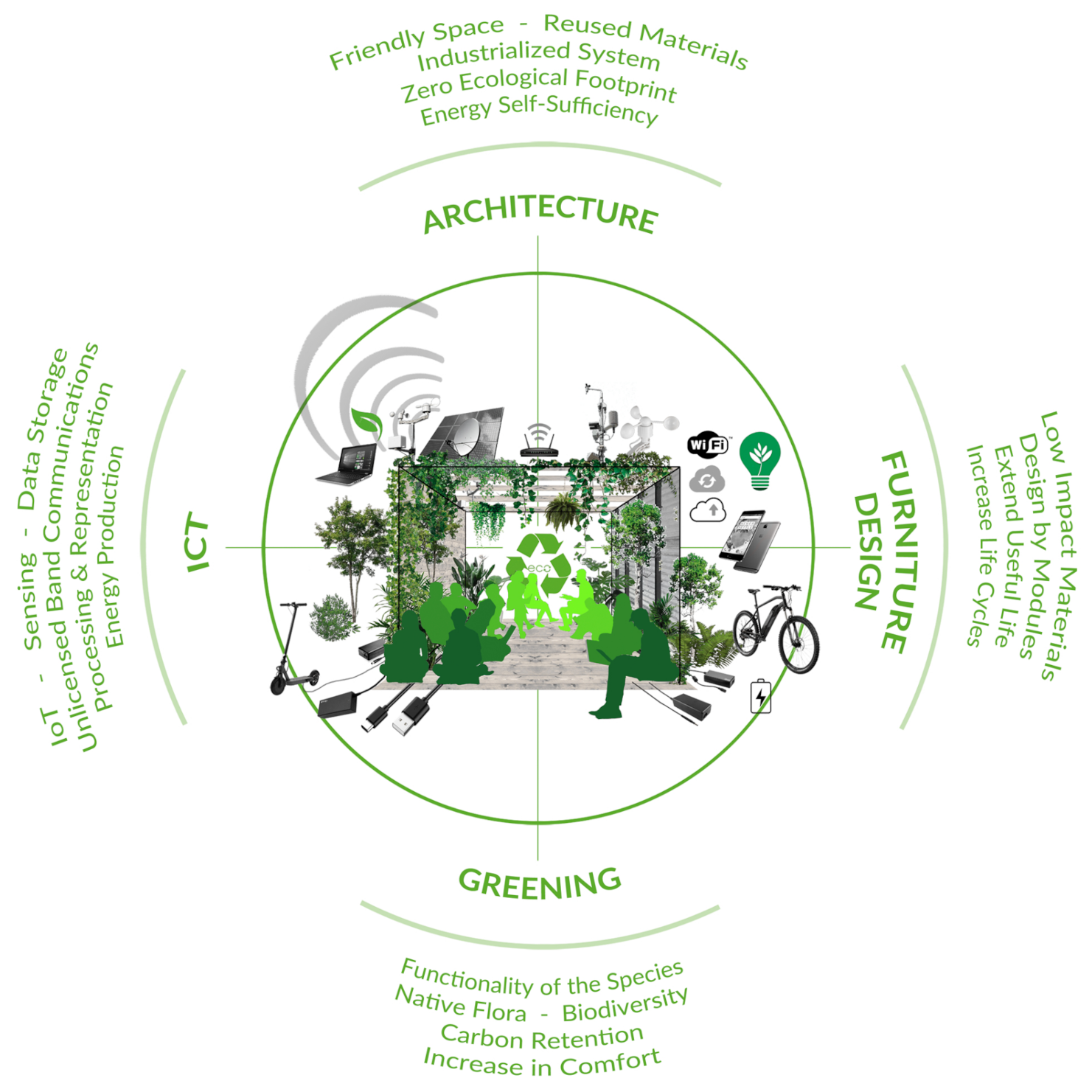
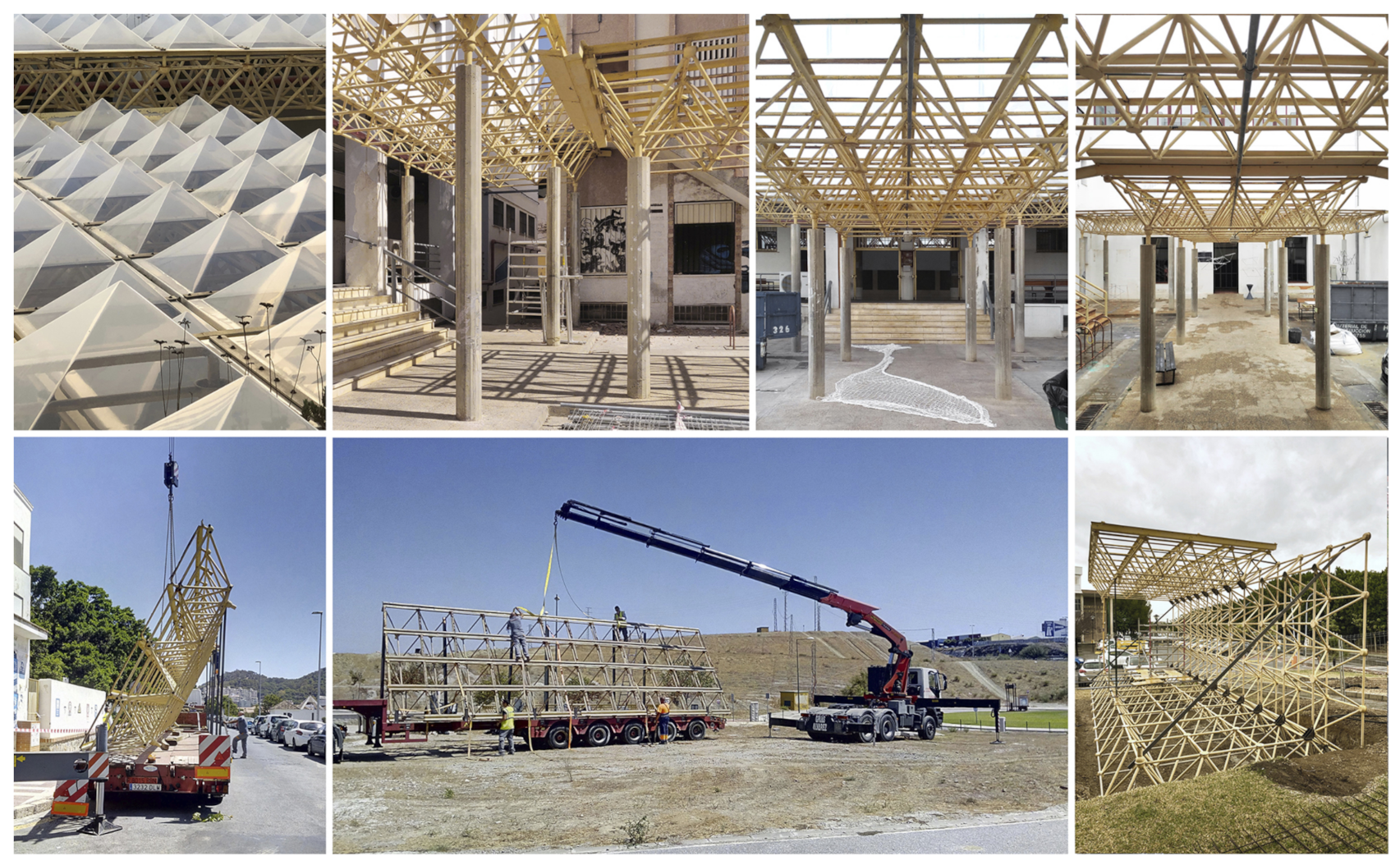

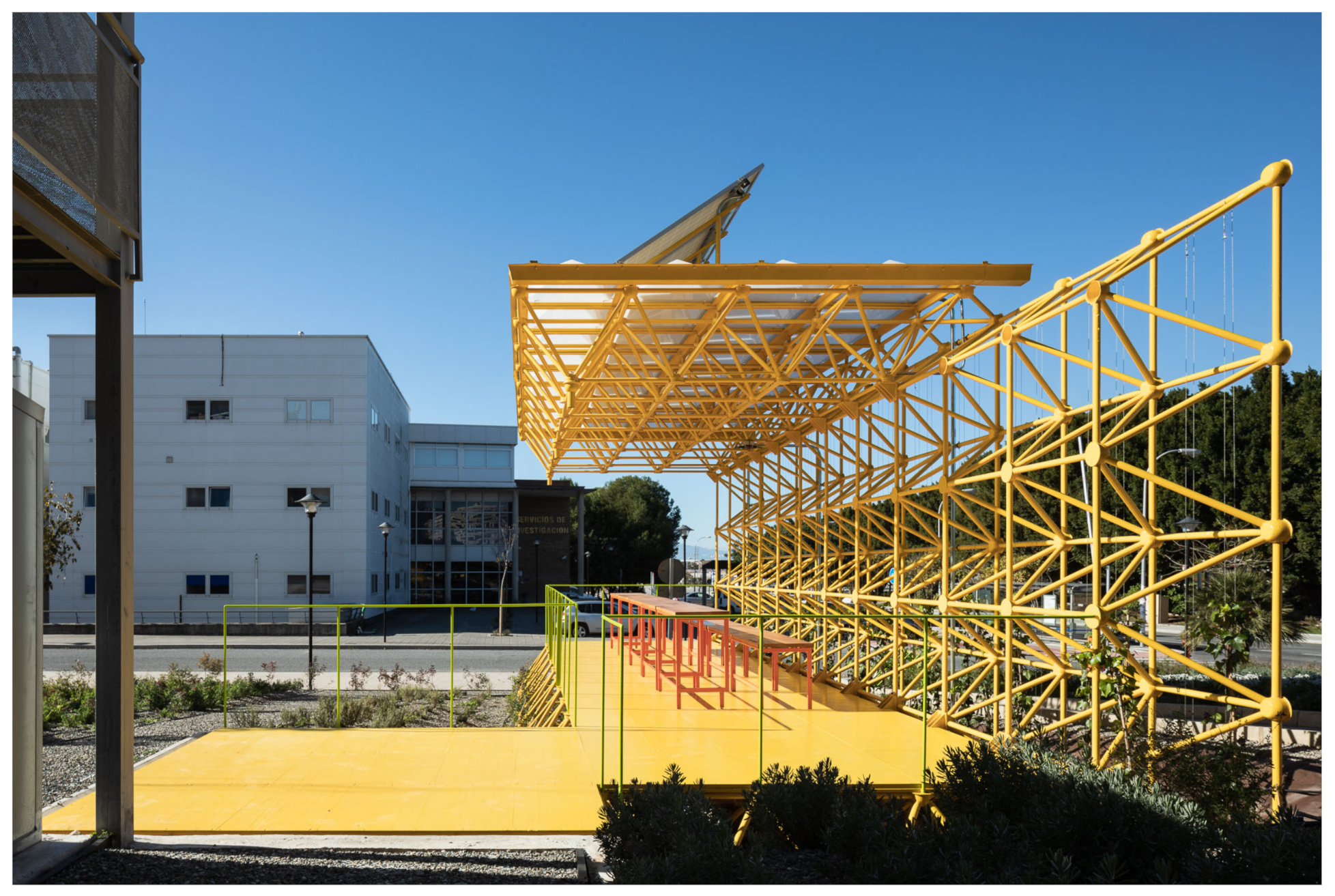
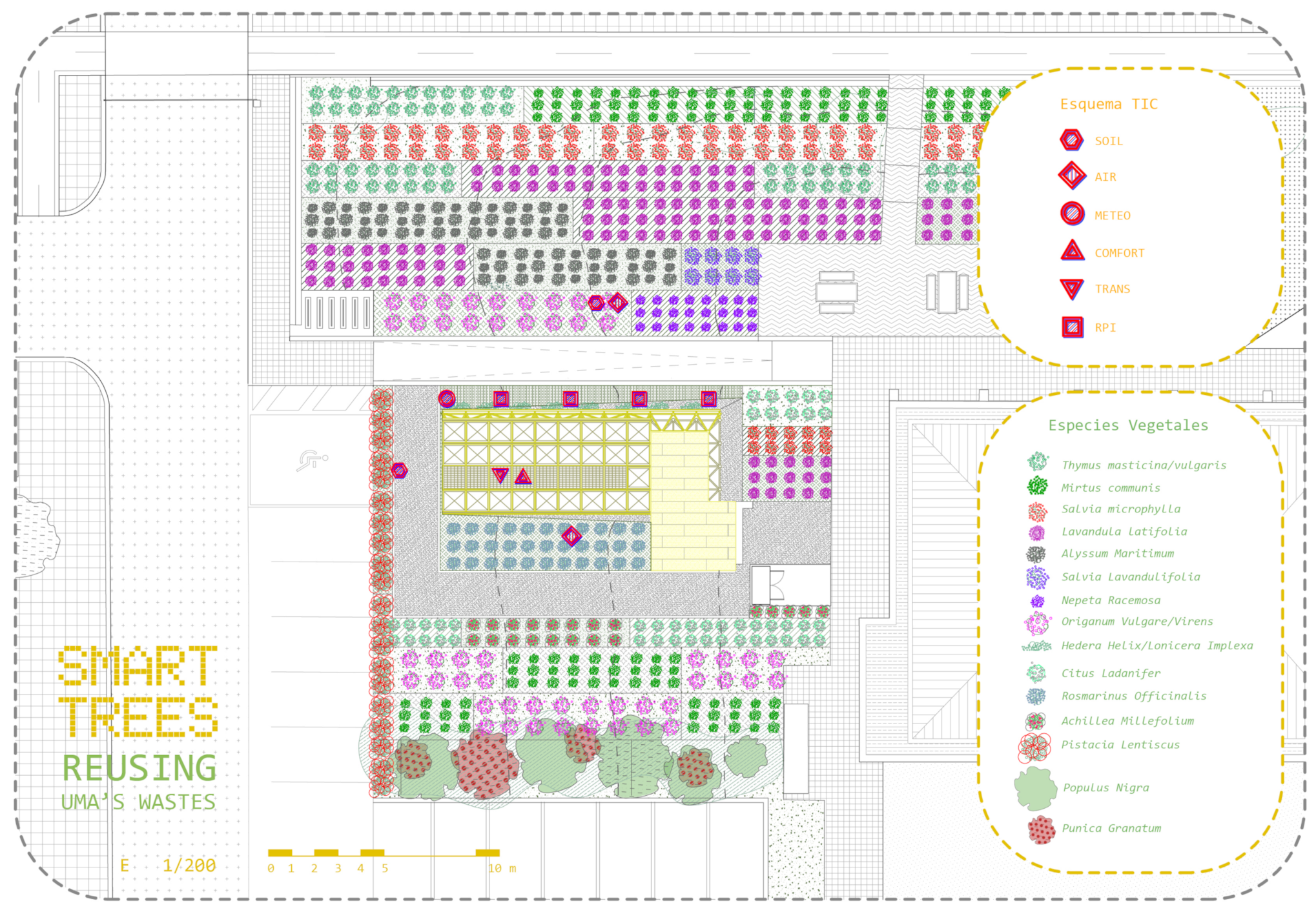


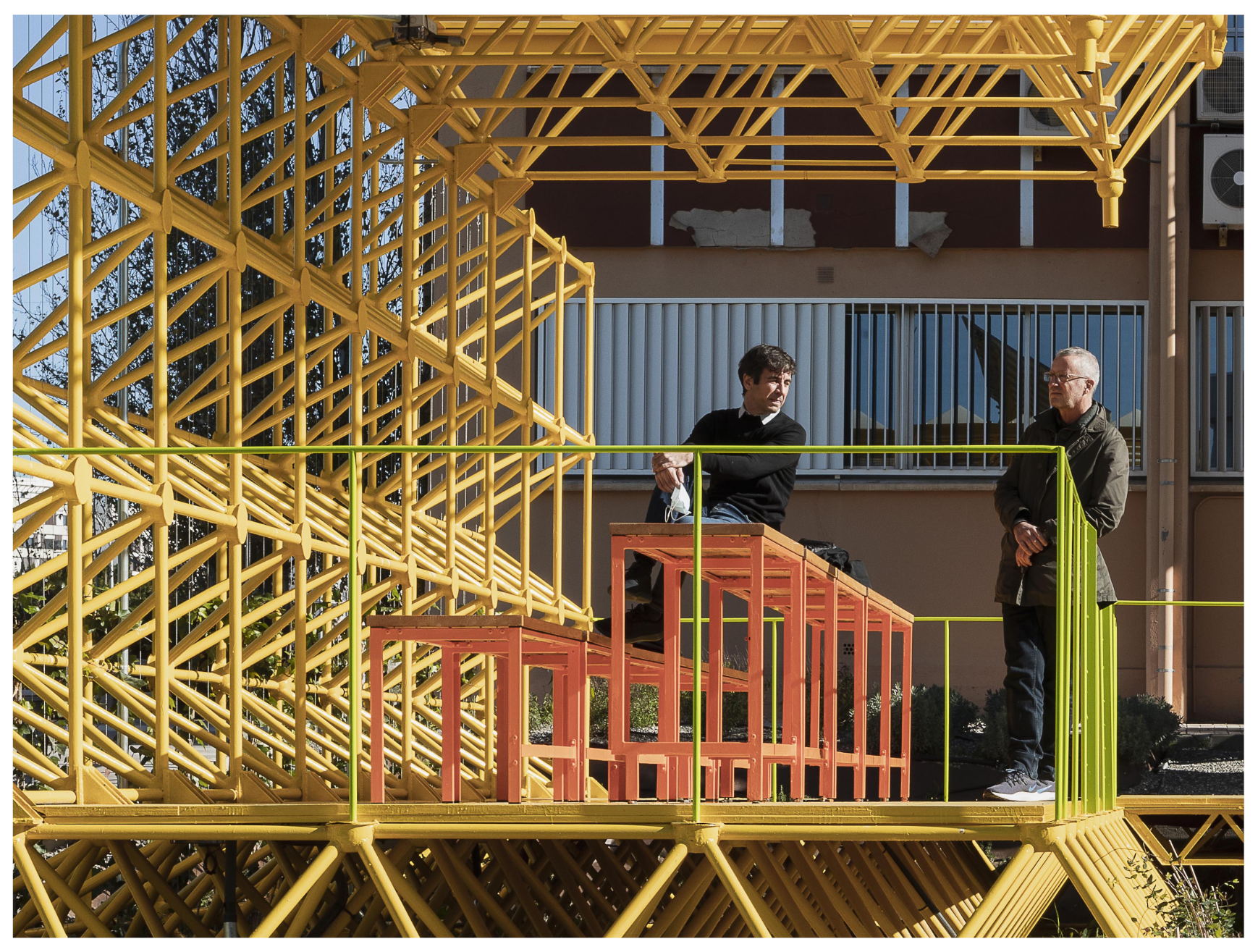
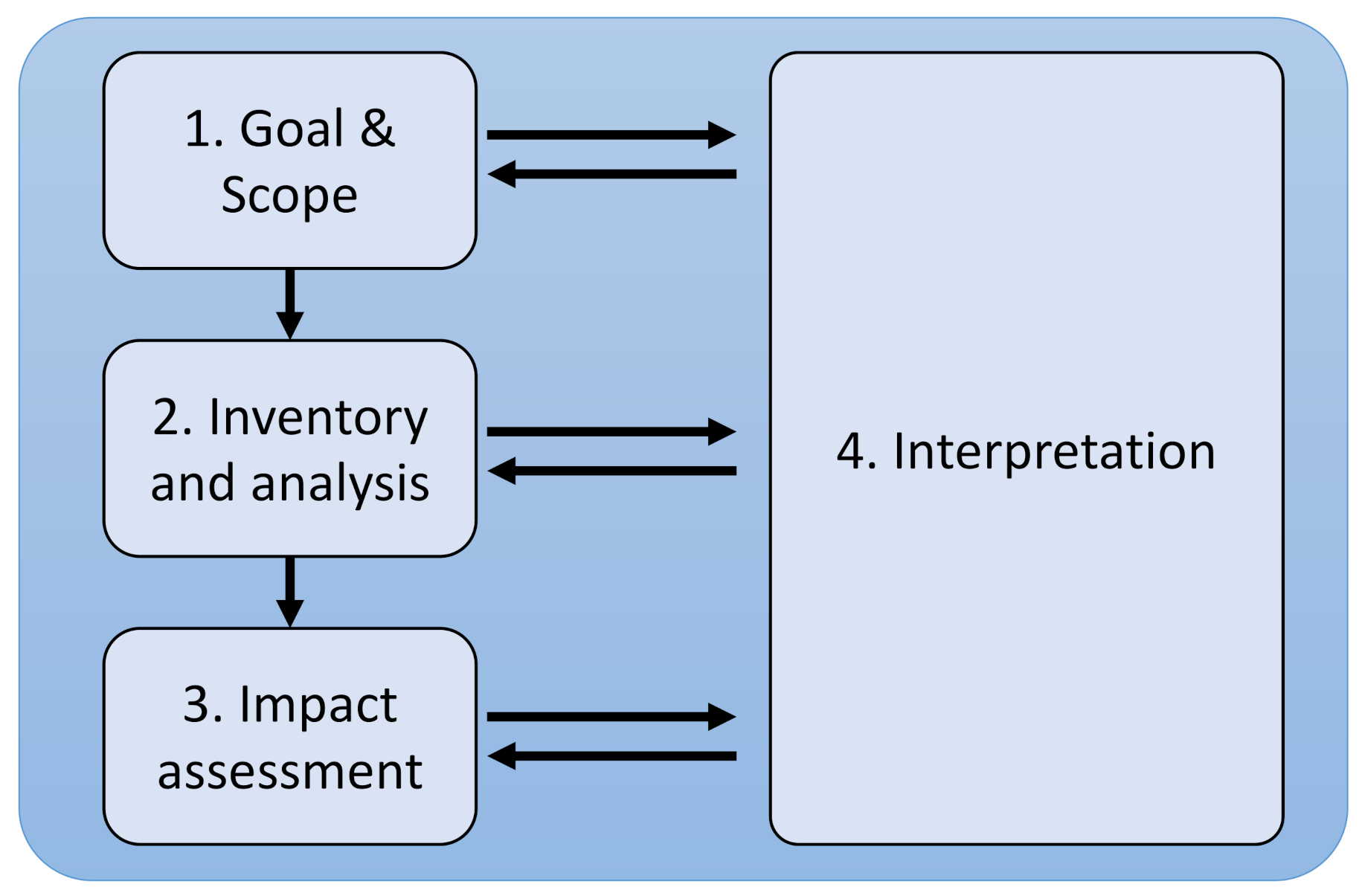
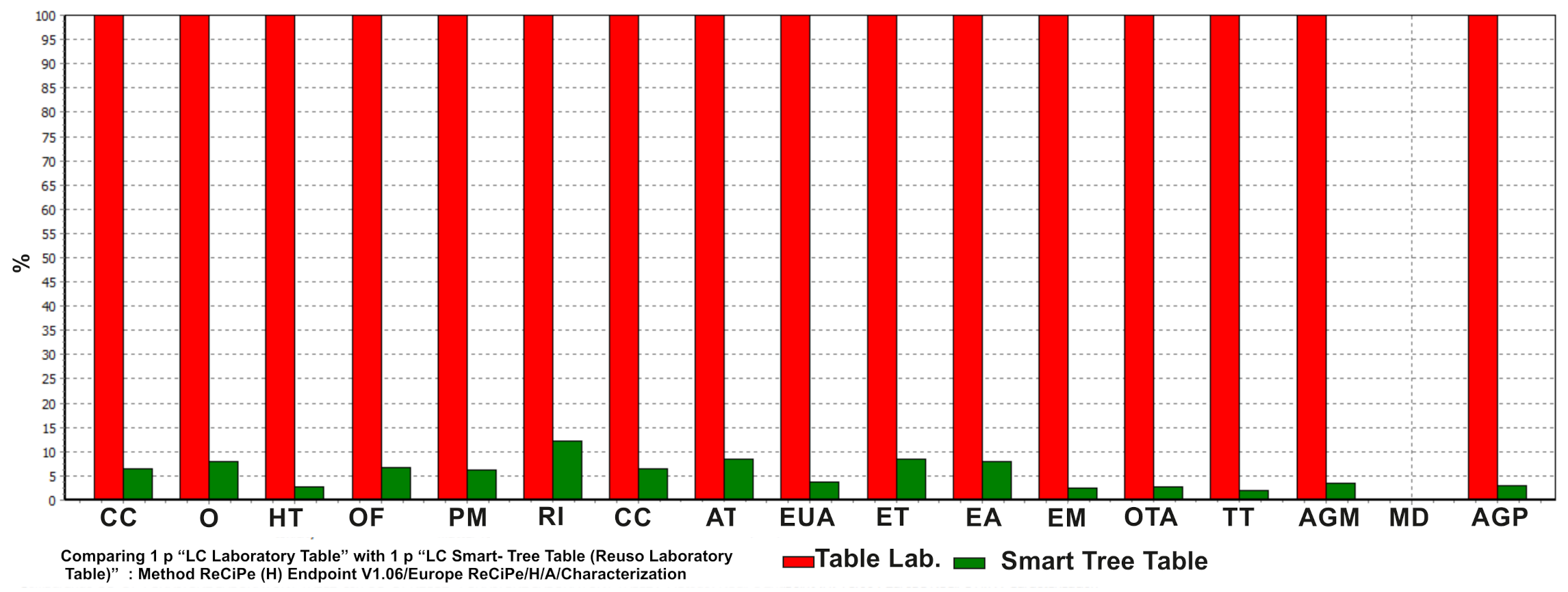
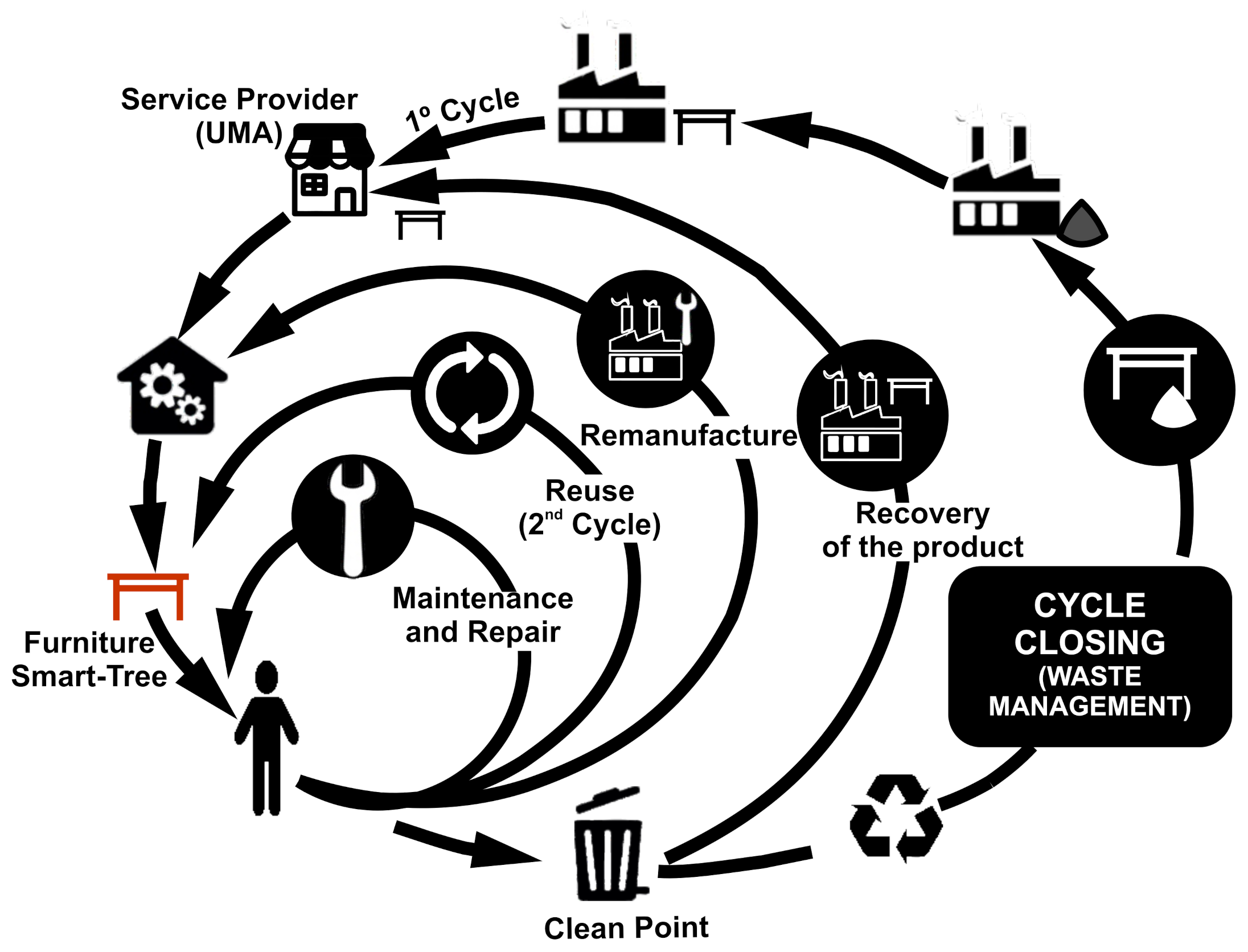


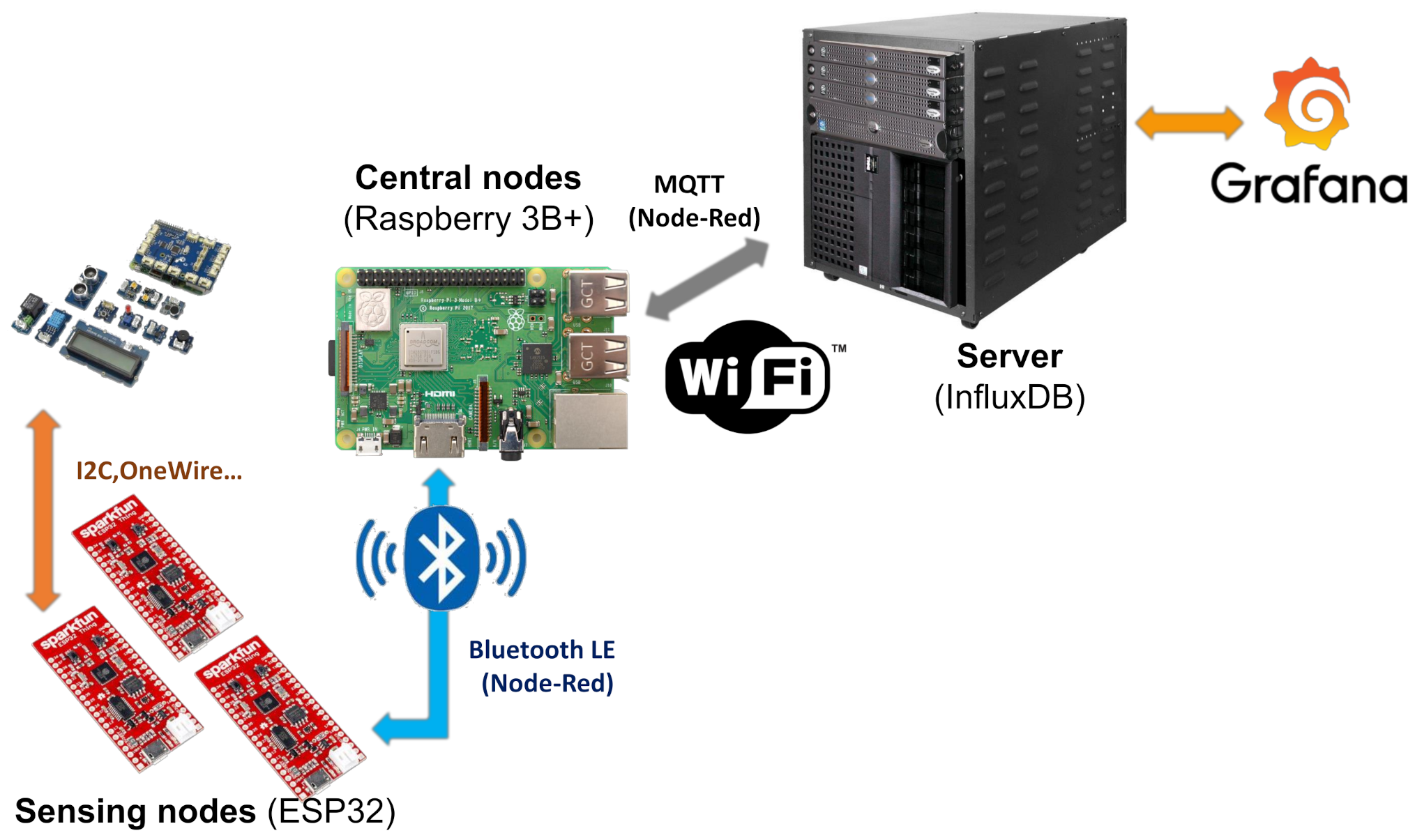

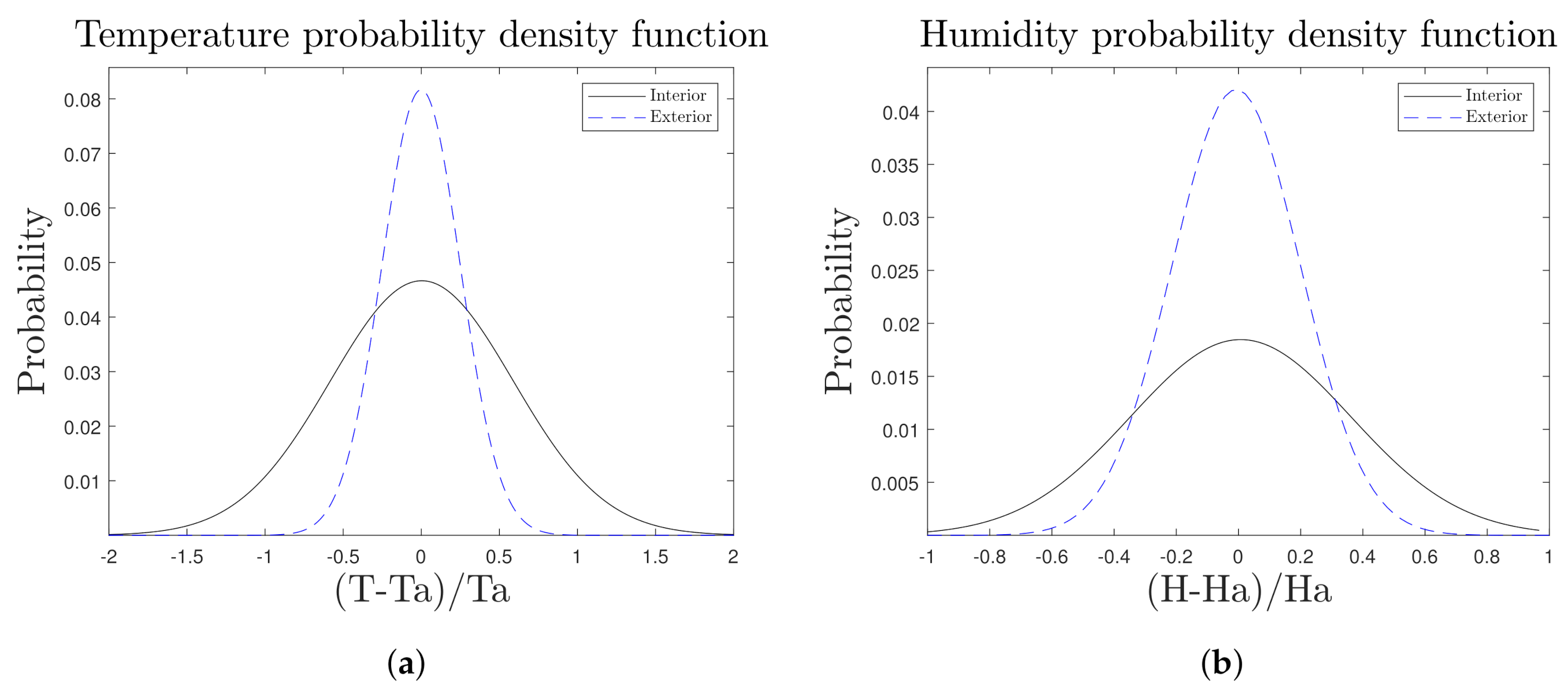

| Node | Sensors | Measurement | Protocol (ESP32) |
|---|---|---|---|
| SOIL | DS18B20 | Soil temperature (°C) | OneWire |
| SKU-SEN0193 | Soil humidity (%) | Analog | |
| AIR | SCD30 | CO2 concentration (ppm) and ambient temperature (°C) & humidity (%) | I2C |
| COMFORT | BME280 | Ambient temperature (°C), humidity (%) & atmosphericpressure (hPa) | I2C |
| TI-OPT3001 | Illuminance (lux) | I2C | |
| METEO | SEN-15901 | Wind speed (m/s), wind direction (degrees) & rainfall (mm) | |
| BME280 | Ambient temperature (°C), humidity (%) & atmosphericpressure (hPa) | I2C | |
| CCS811 | Air quality (Total Volatile Organic Compounds) | I2C | |
| APDS-9301 | Illuminance (lux) | I2C |
| Location in the Architectural Structure | Plant Groups | Function | Sensor Monitor |
|---|---|---|---|
| Northern green wall | Evergreen shrubs | Acoustic Wall | SOIL |
| Myrtus communis (Myrtaceae) | AIR | ||
| Western green wall | Evergreen shrubs | Pollution barrier | SOIL |
| Pistacia lentiscus (Anacardiaceae) | |||
| Southern green wall | Winter deciduous trees and shrubs | Visual barrier | AIR |
| Populus nigra (Salicaceae) | Pollution barrier | ||
| Punica granatum (Punicaceae) | Sunlight seasonal filter | ||
| Colour seasonally | |||
| Birds feeding | |||
| Bands (plain soil around) | Mediterranean-type xerophytic scrubs | Ecosystem model | SOIL |
| Lavandula latifolia (Labiatae) | Aromatic buffer | AIR | |
| Salvia lavandulifolia (Labiatae) | Bees | ||
| Alyssum maritimum (Brassicaceae) | Chromatic (flowers, leafs) | ||
| Cistus ladanifer (Cistaceae) | |||
| Origanum vulgare (Labiatae) | |||
| Achillea millefolium (Asteraceae) | |||
| Vertical greened of the northern metallic tubular structure | Climbers | Acoustic and green wall | SOIL |
| Lonicera etrusca (Caprifoliaceae) | Wind Wall | AIR | |
| Hedera helix (Araliaceae) | Bioclimatic internal comfort | COMFORT (internal) | |
| Bottom and ground | Prostrate scrubs | Soil and structure covering | SOIL |
| Rosmarinus officinalis var. postratus (Labiatae) | AIR |
Publisher’s Note: MDPI stays neutral with regard to jurisdictional claims in published maps and institutional affiliations. |
© 2021 by the authors. Licensee MDPI, Basel, Switzerland. This article is an open access article distributed under the terms and conditions of the Creative Commons Attribution (CC BY) license (https://creativecommons.org/licenses/by/4.0/).
Share and Cite
Fortes, S.; Hidalgo-Triana, N.; Sánchez-la-Chica, J.-M.; García-Ceballos, M.-L.; Cantizani-Estepa, J.; Pérez-Latorre, A.-V.; Baena, E.; Pineda, A.; Barrios-Corpa, J.; García-Marín, A. Smart Tree: An Architectural, Greening and ICT Multidisciplinary Approach to Smart Campus Environments. Sensors 2021, 21, 7202. https://doi.org/10.3390/s21217202
Fortes S, Hidalgo-Triana N, Sánchez-la-Chica J-M, García-Ceballos M-L, Cantizani-Estepa J, Pérez-Latorre A-V, Baena E, Pineda A, Barrios-Corpa J, García-Marín A. Smart Tree: An Architectural, Greening and ICT Multidisciplinary Approach to Smart Campus Environments. Sensors. 2021; 21(21):7202. https://doi.org/10.3390/s21217202
Chicago/Turabian StyleFortes, Sergio, Noelia Hidalgo-Triana, Juan-Manuel Sánchez-la-Chica, María-Luz García-Ceballos, Juan Cantizani-Estepa, Andrés-Vicente Pérez-Latorre, Eduardo Baena, Andrés Pineda, Jorge Barrios-Corpa, and Alberto García-Marín. 2021. "Smart Tree: An Architectural, Greening and ICT Multidisciplinary Approach to Smart Campus Environments" Sensors 21, no. 21: 7202. https://doi.org/10.3390/s21217202
APA StyleFortes, S., Hidalgo-Triana, N., Sánchez-la-Chica, J.-M., García-Ceballos, M.-L., Cantizani-Estepa, J., Pérez-Latorre, A.-V., Baena, E., Pineda, A., Barrios-Corpa, J., & García-Marín, A. (2021). Smart Tree: An Architectural, Greening and ICT Multidisciplinary Approach to Smart Campus Environments. Sensors, 21(21), 7202. https://doi.org/10.3390/s21217202









